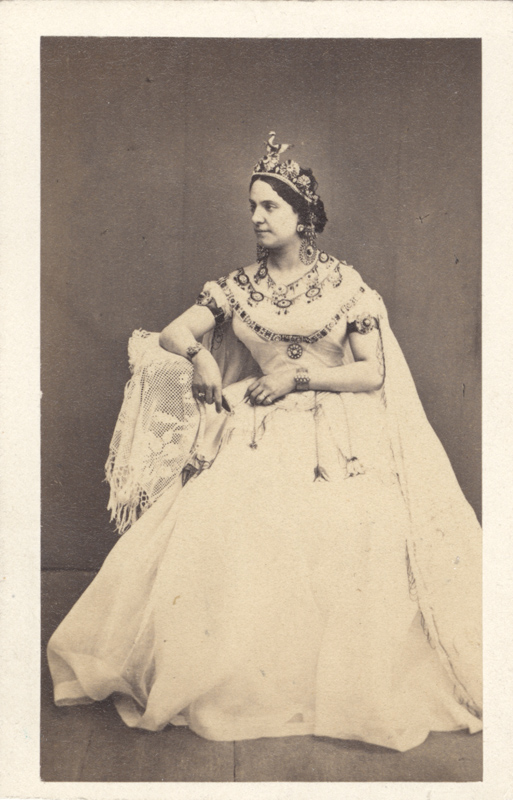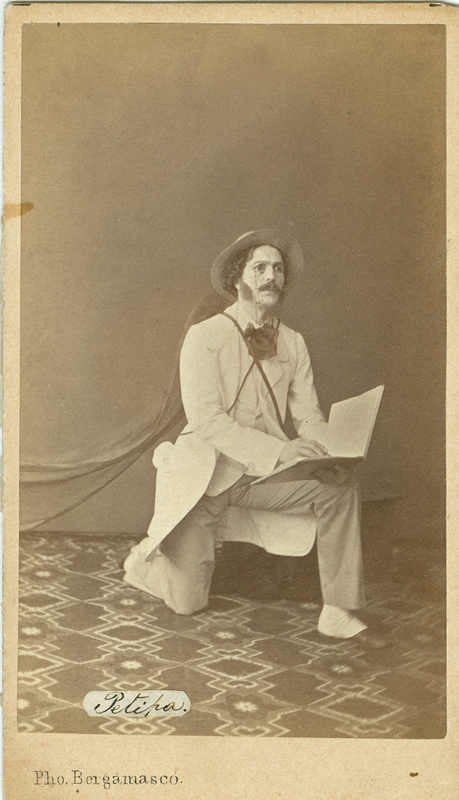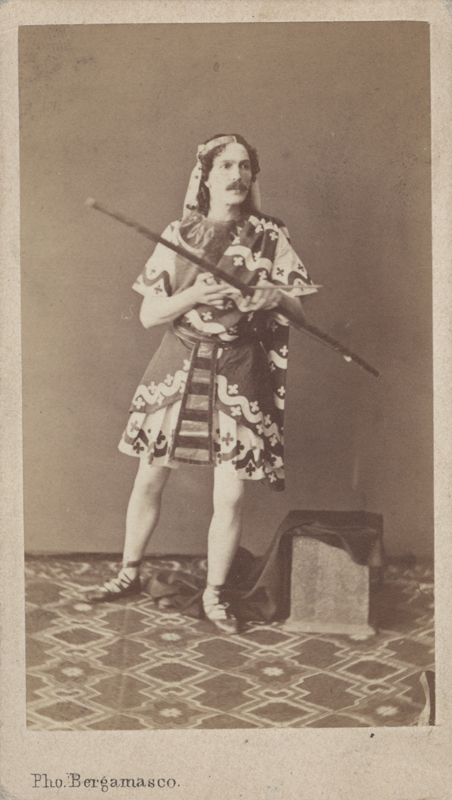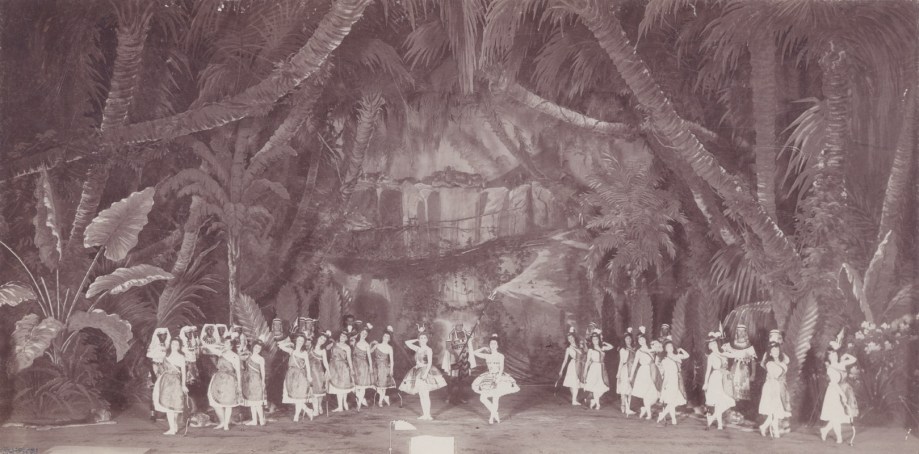Grand ballet in three acts and nine scenes, with a prologue and epilogue
Music by Cesare Pugni
Libretto by Jules Henri Vernoy de Saint-Georges and Marius Petipa
Décor by Heinrich Wagner (Prologue, scene 1; Act 1, scene 1; Act 2, scene 2, Act 3, scene 1) and Andrei Roller (Prologue, scene 2; Act 1, scene 2; Act 2, scene 1; Act 3, scenes 2 and 3)
Costumes by Philippe Calver and Alexei Stoliarov
World Première
30th January [O.S. 18th January] 1862
Imperial Bolshoi Kamenny Theatre, Saint Petersburg
Original 1862 Cast
Princess Aspicia
Carolina Rosati
Lord Wilson/Ta-Hor
Marius Petipa
Ramzea
Lyubov Radina
John Bull/Passifont
Timofei Stukolkin
The Fisherman
Lev Ivanov
The Fisherman’s Wife
Alexandra Kemmerer
The Pharaoh
Nikolai Goltz
The King of Nubia
Felix Kschessinsky
Première of Petipa’s first revival
22nd November [O.S. 10th November] 1885
Imperial Mariinsky Theatre
Original 1885 Cast
Princess Aspicia
Virginia Zucchi
Lord Wilson/Ta-Hor
Pavel Gerdt
Première of Petipa’s final revival
2nd November [O.S. 21st October] 1898
Imperial Mariinsky Theatre
Original 1898 Cast
Princess Aspicia
Matilda Kschessinskaya
Lord Wilson/Ta-Hor
Pavel Gerdt
Ramzea
Anna Johansson
John Bull/Passifont
Sergei Lukyanov
The King of Nubia
Felix Kschessinsky
Plot
The young Englishman, Lord Wilson, is travelling in Egypt with his assistant John Bull. While exploring the desert, in which a great pyramid is situated, a violent sandstorm suddenly brews and the men are forced to take shelter inside the pyramid. Here, they discover the sarcophagus of Princess Aspicia, the beloved daughter of the Pharaoh. Wilson is offered opium, which puts him into a deep sleep. Under the influence of the drug, he is transported back in time to Ancient Egypt in a hallucinatory dream and is transformed into the Ancient Egyptian, Ta-Hor. The mummy of Aspicia miraculously comes to life and she and Ta-Hor fall in love, but her father has promised her to the King of Nubia. Aspicia and Ta-Hor run away together, but Ta-Hor is captured and sentenced to death by snakebite. Aspicia, however, saves her beloved when she threatens to allow the snake to bite her instead and the Pharaoh blesses their marriage, but it is here that the dream comes to an end. Ta-Hor becomes Lord Wilson again, Aspicia returns to her sarcophagus and Lord Wilson resumes his travels.

History
The Pharaoh’s Daughter was Petipa’s first substantial success amongst all of the great ballets he was to create as a choreographer for the Imperial Theatre. Since his arrival in Russia seven years earlier, he had co-produced numerous stagings of Parisian ballets and had created six original one-act and two-act ballets, but for his seventh original ballet, he would take a bigger step into a larger genre, the genre with which he became distinctively associated – the Grand Ballet. When Count Alexander Gedeonov’s time as Director of the Imperial Theatres came to an end, his successor was Andrei Saburov, who proved to be less skilled than his predecessor. Petipa did not think highly of Saburov, writing in his memoirs that the new Director “did not know his business at all, and fulfilled his obligations very carelessly.” In 1859, Saburov invited the Italian Prima Ballerina Carolina Rosati to Saint Petersburg and he did not renew the contract of Jules Perrot, who was the Premier Maître de Ballet at the time. Perrot, however, remained in Saint Petersburg for another year, working without a contract before he returned to Paris in 1860. Petipa, who was still Premier Danseur at the time, hoped that he would be named as Perrot’s successor, but instead, the position of Première Maître de Ballet was given to his rival Arthur Saint-Léon. Despite missing out on his desired position, however, Petipa’s golden opportunity to prove himself as a choreographer was still to come.

Carolina Rosati stayed with the Imperial Ballet for three seasons before her retirement from the stage in 1862. In accordance with her contractual rights, which she was determined to take advantage of, she was granted a benefit performance in which she would dance in a new grand ballet. Petipa was commissioned to create and choreograph this new work and Cesare Pugni was commissioned to compose the music score. Petipa had sketched out a plan for the new ballet before he and his wife Maria Surovshchikova-Petipa embarked on their 1861 tour to Paris. During their time in the French capital, Petipa met the renowned librettist Jules Henri Vernoy Saint-Georges, who devised the plot for the new ballet, which was to be based on Théophile Gautier’s 1858 novel Le Roman de la momie (The Romance of the Mummy), which told the story of a young lord named Evandale who falls in love with an Ancient Egyptian woman named Tahoser, who has been dead for 3500 years, but whose body and beauty have miraculously remained perfectly preserved. On their way back to Saint Petersburg, the Petipas visited the Egyptian Museum in Berlin, where Petipa obtained inspiration for his new ballet, which was to be called The Pharaoh’s Daughter. In his memoirs, Petipa writes the following account of his visits to this museum:
On the way back I visited the Egyptian Museum in Berlin, with the tombs of the Pharaohs, which had Egyptian paintings on them. All these Egyptian paintings depicted the figure in profile, because at that period artists did not know how to draw it in any other way.
I studied all these paintings attentively, but naturally I surmised that the profile positions were the result of the insufficiently developed craftmanship of the painters, and did not compel the artists of The Daughter of the Pharaoh to dance only in profile. Although their painters drew people in a certain way, the Egyptians certainly walked as we do, that is, in a straight direction. – Russian Ballet Master: The Memoirs of Marius Petipa (p. 50)

However, during Petipa’s absence from Saint Petersburg, Rosati and Saburov had a disagreement, which resulted in a delay in informing Petipa when rehearsals were due to start for The Pharaoh’s Daughter. The delay continued until two months before the end of the season and Petipa had still not put the production together; time was running out before the scheduled date for Rosati’s benefit performance. Rosati was convinced that Saburov was deliberately forgetting about her benefit performance and the new ballet, so she and Petipa arranged to speak to Saburov about the matter. According to Petipa, the Director informed them that there was no money for the production, only for him to then end up in a compromising situation in front of them. This incident resulted in Saburov quickly changing his mind and allowed for The Pharaoh’s Daughter to be staged. Petipa gives an amusing account of this meeting in his memoirs:
I entered and found the Director in his dressing gown, as usual. From the day he began his duties, he received all the artists, men and women, in this costume… Of course, the Director’s dressing gown did not shock me.
“M. Petipa! Why have you and Mlle. Rosati come to see me?”
“To remind Your Excellency about the production of the ballet which must be given at her benefit.”
“We cannot even consider a new ballet. We have neither the time nor money for it.”
“Will you be so kind, You Excellency, as to give her this unpleasant news yourself? She is waiting in the salon.”
“I can’t receive her in my dressing gown, can I?”
“If you grant her request, she will not mind.”I went to the salon, and saying nothing to the ballerina about the Director’s decision, I waited with her for his appearance. He came out almost immediately after me, in his elegant green dressing gown, and hardly greeting her, asked to what he owed the pleasure of seeing her.
“I have come, Your Excellency, to discuss the ballet which M. Petipa is to stage for my benefit.”
“Unfortunately I am forced to inform you, Madame, that at the moment we do not have the money to stage such a big ballet.”
“But indeed, Your Excellency, this was stipulated in my contract,” fumed Rosati.
“I know, Madame! We will recompense you so liberally that you will have nothing to regret.”
“Permit me to point out to you, M. le Directeur, that artists who enjoy a certain renown appreciate honours more than money.”
“Perhaps, Madame; but unpleasant as it is for me, I can only repeat to you that because of unforeseen circumstances The Daughter of Pharaoh cannot be staged this season.”
“Then it seems to me that you do not attach any value to your signature.”
“Madame!”
The Director became very agitated. Trembling, in a fit of irritation he flung on leg over a chair; the dressing gown, of course, fell open. My pen refuses to describe what we saw.
“Do not forget, Madame, that you are speaking to a high official”
Afraid to look up, Mlle Rosati cast her eyes down, and had to turn aside to keep from laughing.The visibility of His Excellency’s person did not help to increase his prestige, and I considered it my duty to hurry to his assistance and screen him from view, because it was plainly to be seen that his whole body was literally shaking with rage.
Then Saburov, too, noticed what his treacherous dressing-gown had done, and quickly took his foot off the chair, and began to mutter:
“Excuse me, Madame, excuse me!”
This critical incident quickly cooled their tempers, and the Director turned to ask me:
“M. Petipa, can you stage this ballet in six weeks?” – Russian Ballet Master: The Memoirs of Marius Petipa (p. 50-52)
To stage such a colossal production in just six weeks was no easy task and Petipa barely slept through the process. Despite the haste in the staging and completion, however, The Pharaoh’s Daughter premièred on the 30th January [O.S. 18th January] 1862 at the Imperial Bolshoi Kamenny Theatre with Rosati as Princess Aspicia and Petipa as Lord Wilson/Ta-Hor. With its colossal décor depicting a huge Egyptian jungle, the Pharaoh’s palace and an enchanted underwater kingdom, The Pharaoh’s Daughter was a magnificent success and proved that Petipa could properly compete with his rival Saint-Léon. Although the ballet contained a few dramatic mime scenes, it was never meant to be a great work of drama, but rather a highly entertaining, excessive spectacle where the audience could have the most fun and excitement watching a ballet taking place in distant, exotic locale. In the aftermath, Petipa was named second ballet master to Saint-Léon, but he did not officially retire from the stage until 1869. After Rosati’s departure from Saint Petersburg, the role of Princess Aspicia was inherited by Maria Surovshchikova-Petipa, who was greatly celebrated in the role.

Subsequent revivals
In 1885, Petipa staged his first revival of The Pharaoh’s Daughter. This revival was intended for the benefit performance of Eugenia Sokolova, but less than a fortnight before the performance date, Sokolova injured her leg and was forced to withdraw. This sent the management of the Imperial Theatres into a bit of a frenzy, for it was too late to change the schedule. For that same season, the great Italian Prima Ballerina Virginia Zucchi had been invited to Saint Petersburg, but her début had been scheduled for December in the Saint Petersburg première of Peter Ludwig Hertel and Paul Taglioni’s La Fille mal gardée. Knowing how much the Saint Petersburg balletomanes were anticipating Zucchi’s arrival, an urgent telegram was sent to her, begging her to come to Saint Petersburg a fortnight earlier than planned. Since she had no other engagements elsewhere, Zucchi complied with their request and arrived in the Imperial Russian capital on the 13th November [O.S. 1st November] 1885. It was only after her arrival that she was informed that there had been a change of plans for her debut performance and that she would now dance the role of Princess Aspicia in The Pharaoh’s Daughter in less than a fortnight. At first, Zucchi refused since she was completely unfamiliar with the ballet, but when the subject was explained to her, she thought it had possibilities and accepted the role.
When it was announced that Virginia Zucchi would be performing Princess Aspicia, all the tickets for her new debut performance sold out within just a few hours. During the preparations of Zucchi’s Saint Petersburg début, an interesting incident occurred. Zucchi had difficulty adapting to the type of tutu that was used in Russia at the time, which had longer skirts than the type that was used in her native Italy. She, therefore asked for the skirts on her costumes to be shortened, but when her request was denied, she took the liberty to shorten them herself so she could dance more comfortably, much to the shock of Petipa. Luckily, Zucchi avoided any scandal over the matter and subsequently, the Russian ballerinas went onto follow her example and the Russian tutu skirt was shortened thereafter.
Petipa’s first revival of The Pharaoh’s Daughter premièred on the 22nd November [O.S. 10th November] 1885 at the Imperial Mariinsky Theatre. The revival was hugely successful and Zucchi’s performance was a triumph on its own right. According to eye witness accounts, the Grand Duke Vladimir, who attended the performance, was heard shouting, “Bravo, Zucchi!” from the Imperial Box.
Petipa revived the ballet for the final time on the 2nd November [O.S. 21st October] 1898 for the benefit performance of Anna Johansson, who danced the role of Ramzea, with Matilda Kschessinskaya as Princess Aspicia.

The Pharaoh’s Daughter in the 20th century
By the turn of the 20th century, The Pharaoh’s Daughter was the most popular ballet in the Imperial Ballet repertoire and was even Petipa’s favourite of his works, if not certainly one of his favourites. There are contemporary accounts of grand evenings at the Imperial Mariinsky Theatre where everyone of rank and royalty came to watch The Pharaoh’s Daughter and Kschessinskaya would play host at such evenings as Princess Aspicia, complete with her glittering décolletage of fabulous Fabergé diamonds. The old Maestro Petipa would write in his diary of how any performance of The Pharaoh’s Daughter was “…a great success.”
Petipa’s final revival of The Pharaoh’s Daughter was notated in the Stepanov notation method between 1903 and 1906 and is part of the Sergeyev Collection.
In 1909, the ballet was first presented to the west in a tour of Scandinavia, the Baltic States and Germany by a troupe of dancers from the Imperial Ballet, with Anna Pavlova as Prima Ballerina. In the 1908-09 season, Matilda Kschessinskaya was invited to dance in Paris and as part of her appearances, she introduced the Parisian audiences to her favourite variation from The Pharaoh’s Daughter when she danced in the ballet La Korrigane and the variation was met with great success.
In 1905, Alexander Gorsky revived and staged The Pharaoh’s Daughter for the Imperial Bolshoi Ballet in Moscow. This revival greatly angered and upset Petipa, since the ballet was one that he greatly cherished. In his memoirs, Petipa launches a vicious attack on Gorsky for the revival of his works:
Formerly, every well-known ballet master began his career on second or even third-rate stages. But my pupil, Gorsky, in spite of the fact that he had never, anywhere, staged a work of his own, was immediately honoured with an invitation to the Bolshoi Theatre of Moscow, in the capacity of ballet master…
… It is not my fault that M. Gorsky, to please his patron, followed another path, and in stealing my works began to put them into such “novelty” as can in no way serve to his advantage. In Moscow he staged my ballet Don Quixote, which had already had more than two hundred performances, and in order to present “something new” to please the new Director, he changed the names of the characters: the daughter of Pharaoh, Aspicia, was changed to Binte-Tante, etc. Instead of one daughter of Pharaoh, there were three; why didn’t he give him a round dozen, to please the young ballet public? How much talent do you suppose is necessary for such “innovations”? What a genius!
“What impertinence!” competent people can only say. This same Gorsky, and other obliging followers of the innovator-colonel (Teliakovsky), permitted themselves to cripple even the theme and subject of my ballet, just to give opportunities to the decadent painters who enjoyed the favour of the all-powerful lady who ruled the Imperial Theatre (Mme Teliakovsky – L.M.). In order to make a new décor for the bank of the Nile, they ruled out the fisherman’s hut as superfluous. What was the result? In the scene where the Nubian King pursues and tries to capture Aspicia, she can run anywhere she wants, and there is no need for her to throw herself into the water. The effectiveness of the scene is lost, and the meaning of the story mutilated, but what does this matter to people who are trying to please only one self-confident, self-centred, obstinate person? – Russian Ballet Master: The Memoirs of Marius Petipa (p. 78-79)
As he did with all his revivals of Petipa’s ballets, Gorsky inflicted his innovations onto The Pharaoh’s Daughter that included his abandonment of strictly symmetrical patterns and increased dramatic expressiveness in the dancing. Although his revival of The Pharaoh’s Daughter was successful in Moscow, there were plenty of others who shared Petipa’s criticisms. In 1906, Anna Pavlova was invited to Moscow to dance in Gorsky’s revival, but she found the production ludicrous and shortly returned to Saint Petersburg, where, weeks later, she made her début as Princess Aspicia in Petipa’s production.
The Pharaoh’s Daughter was one of the many ballets that did not survive in post-revolution Russia due to the fact that the Soviet authorities felt the work was of “negligible artistic value”. This was mostly due to the fact that, in many ways, the new regime felt that the ballet was a perfect example of the theatrical excesses of the Imperial Russian Court. The Pharaoh’s Daughter was performed for the final time by the former Imperial Ballet in 1928, after which, in many ways, it passed into legend in the annals of ballet history. Rudolf Nureyev had expressed interest in reviving the ballet for the Paris Opera Ballet, but his failing health and eventual death in 1993 prevented him from ever doing so.
Today, the only production of The Pharaoh’s Daughter that is performed is French choreographer, Pierre Lacotte’s production for the Bolshoi Ballet, which, in many ways, is a heavy deviation from Petipa’s production. For his production, Lacotte chose not to follow the notation scores after refusing to believe that excerpts of the notated choreography that he had been shown could have been Petipa’s choreography. Stepanov notation expert, Doug Fullington reconstructed the notated river variations for him, but Lacotte took a dislike to the choreography, stating that it was “too old-fashioned to be Petipa”. In the end, he completely re-choreographed the ballet in his own design, even rearranging and making quite drastic changes to Pugni’s score. He also restored several variations that have survived and been passed on through the personal recollections of great Russian dancers of the past, including his teacher, Lyubov Egorova, one of Petipa’s ballerinas. However, Lacotte’s efforts to stage The Pharaoh’s Daughter based on dancers’ recollections were not always successful. One of the dancers he consulted on the matter was the Bolshoi Prima Ballerina, Marina Semyonova, a celebrated student of Agrippina Vaganova, who had danced the role of Princess Aspicia only once in her career. Lacotte’s visit to Semyonova proved to be in vain as she claimed that she could not remember anything about her one-off performance as Aspicia or anything else about the ballet. Lacotte’s production of The Pharaoh’s Daughter was met with success and has since remained a popular member of the Bolshoi Ballet’s repertoire.

The Underwater Kingdom
The most spectacular scene in The Pharaoh’s Daughter was perhaps the Underwater Kingdom scene. In this scene, Aspicia has thrown herself into the Nile to escape from the clutches of the King of Nubia and descends into the underwater realm of Father Nile. The god welcomes Aspicia with open arms, after which the Grand Pas des fleuves, ruisseaux et sources is performed. In this grand pas, the corps de ballet (which includes a group of children) represent rivers, streams and sources and six variations are performed by soloists who represent six rivers from different countries – the River Guadalquivir of Spain, the River Thames of Great Britain, the River Rhine of Germany, the River Huang-ho of China, the River Neva of Russia and the River Tiber of Italy. Afterwards, a Pas de la Vision is performed, in which Aspicia is shown a vision of her beloved Ta-Hor and begs to return to him; this pas is parallel to the vision scenes from The Sleeping Beauty and Raymonda. The scene ends with Aspicia ascending to the surface on a giant mother-of-pearl shell.

Sources
- Petipa, Marius, Russian Ballet Master: The Memoirs of Marius Petipa. Translated ed. by Helen Whittaker, introduction and edited by Lillian Moore. London, UK: Dance Books Ltd (1958)
- Petipa, Marius, The Diaries of Marius Petipa. Translated ed. and introduction by Lynn Garafola. Published in Studies in Dance History 3.1. (Spring 1992)
- Meisner, Nadine (2019) Marius Petipa, The Emperor’s Ballet Master. New York City, US: Oxford University Press
- Ezrahi, Christina (2012) Swans of the Kremlin: Ballet and Power in Soviet Russia. US, UK: University of Pittsburgh Press, Dance Books Ltd
- Guest, Ivor (1977) The Divine Virgina: A Biography of Virginia Zucchi. New York, US: Marcel Dekker, Inc.
- Kant, Marion/Various (2007) The Cambridge Companion to Ballet. Cambridge, UK: Cambridge University Press
- Kschessinskaya, Matilda, H.S.H. The Princess Romanovsky-Krassinsky (1960) Dancing in Petersburg: the Memoirs of Mathilde Kschessinskaya. Alton, Hampshire: Dance Books Ltd
- Pritchard, Jane with Hamilton, Caroline (2012) Anna Pavlova: Twentieth-Century Ballerina. London, UK: Booth-Clibborn Editions
- Scholl, Tim (1994) From Petipa to Balanchine: Classical Revival and the Modernization of Ballet. Abingdon, Oxfordshire, UK: Routledge
- Wiley, Roland John (2007) A Century of Russian Ballet. Alton, Hampshire, UK: Dance Books Ltd
- Bolshoi Ballet: Theatre program for The Pharaoh’s Daughter. Bolshoi Theatre, 2001
Photos and images: © Dansmuseet, Stockholm © Большой театр России © Victoria and Albert Museum, London © Государственный академический Мариинский театр © CNCS/Pascal François © Bibliothèque nationale de France © Musée l’Opéra © Colette Masson/Roger-Viollet © АРБ имени А. Я. Вагановой © Михаил Логвинов © Михайловский театр, фотограф Стас Левшин. Партнёры проекта: СПбГБУК «Санкт-Петербургская государственная Театральная библиотека». ФГБОУВО «Академия русского балета имени А. Я. Вагановой» СПбГБУК «Михайловский театр». Михаил Логвинов, фотограф. Martine Kahane.
